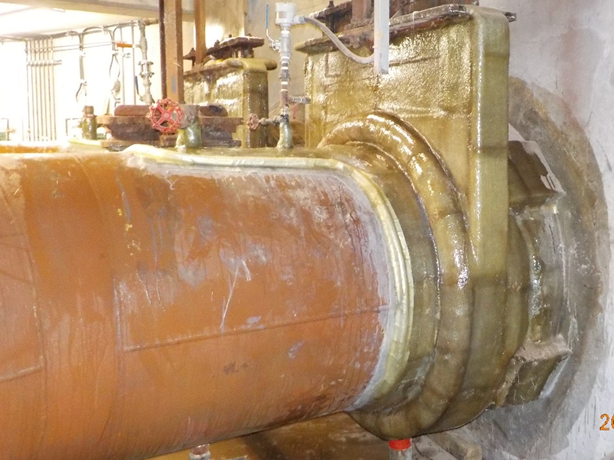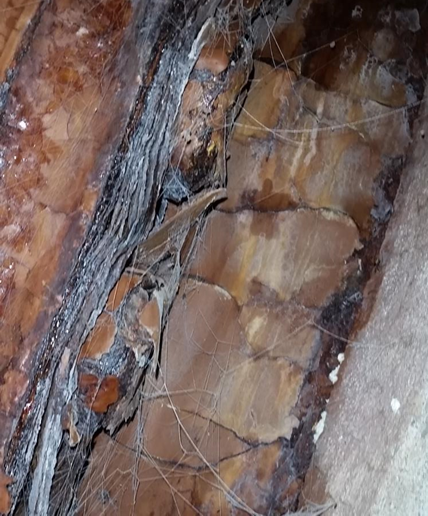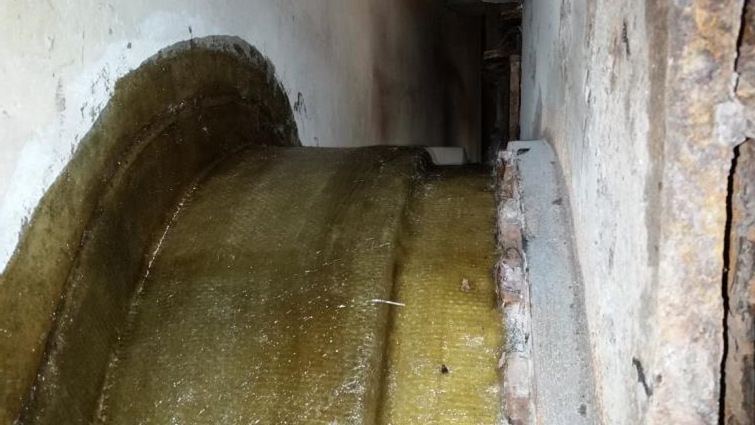Case Study: Waste Water Force Main Emergency Repair
FRP repair on steel piping in wastewater service
Fiberglass-Reinforced Plastic (FRP) repair was successfully designed and installed to replace corroded steel piping in wastewater service without interruption of service. UltraAnalytix® non-destructive testing was utilized to ensure quality control and assurance during each phase of construction and ongoing monitoring through frequent inspections.
Industry: Municipal Wastewater

Background
Wastewater from residential and businesses is collected into wet wells within pumping stations through gravity fed pipelines. When it reaches a certain level in the wet well, pumps automatically turn on. The pumps in these stations are used to increase the pressure of the wastewater in the force mains to be able to overcome the elevation changes while being sent to the wastewater treatment facility.
As part of a large collection system, the municipal client operates and maintains a number of wastewater pumping stations throughout a populated city in Canada.
The client contacted UTComp requesting an inspection and assess the integrity of the pumping station’s two force mains. Due to the extensive corrosion both internally and externally, a rehabilitation was needed quickly and conveniently as the force mains were too vital to be shutdown for complete replacement.
The City began investigating options to repair the corroded steel force mains while leaving the force mains in service. After considering several repair options, they decided on using UTComp FRP expert engineering services to design and oversee the FRP repair of the corroded force mains for quality assurance and compliance with the design. This also included ongoing inspections to assess the integrity of the repair.
FRP Repair Project Description
UTComp was requested to inspect and assess the integrity of a certain pumping station’s force mains. The two existing steel force mains used to transfer wastewater from the pumps were inspected by ultrasonic thickness measurement and found to be corroded internally as well as externally. There was very low remaining thickness which posed a critical risk of loss of containment. They required immediate repair. These large force mains are vital in transferring wastewater to the treatment system and could not be place out of service long enough for a replacement. No shutdown could possibly be scheduled in the near future.
The City began investigating options to repair the corroded force mains while leaving the force mains in service. After considering several repair options and consultation, they decided to use UTComp to design and oversee the FRP repair of the corroded force mains. The city’s decision to utilize UTComp’s expert knowledge and specialized skills on the standards and codes relating to FRP, as well as our experience in finding solutions for safe optimal operations was proven to be the right choice.
During the inspection, no liquid sewage leaks were noted but there was possible seepage through the corroded pipe. While there was a long-term plan to replace this system, this immediate repair needed to be leak tight and reliable for up to 25 years. FRP has been used effectively for piping systems where corrosion is a concern in a wide range of applications and industries. The repair was designed on the assumption that the steel will eventually corrode through its thickness, then leak. The FRP would be designed to provide full structural, leak-tight replacement for the corroded steel pipe from the concrete bulkhead/ collar to the inlet piping past the force main valve. This work consisted of designing and applying FRP reinforcement to contain the force main contents in case of corrosion failure and provide structural support to the knife gate valve.
Formation of FRP consists of wetting fabric made from glass fibers with liquid resin then placing it over a surface that will support the FRP while the resin hardens from a cross‐linking chemical reaction. When the resin is hardened, it takes the shape of the surface – in effect, the surface acts as a mold. Layers of wetted glass are added and harden to develop the structural strength required. It is normal for FRP pipes to be formed over a mold that is not bonded to the FRP, so that it can be removed while keeping the full developed strength of the FRP. This repair was designed using this principle, where the existing corroded steel pipe was used as a mold to shape the repair, without need to be bonded to the FRP.

Figure 1 corroded steel main
Repair Execution
- Chopped strand glass fabric saturated with resin was wrapped around the corroded pipe so that contaminants and scale from the corroded pipe are contained. Wrapping was done until the outer surface gelled and hardened.
- The surface of the concrete bulkhead, collar, wall, and the steel inlet pipe, flanges and valve body were grounded and prepared for application of FRP.
- Derakane™ 8084 primer was applied to the prepared concrete and steel surfaces. This primer has been proven to provide reliable bonding of FRP to both concrete and steel.
- FRP was then applied as designed to the wrapped pipe, concrete and steel surfaces to provide a leak tight and structurally sound repair. Putty was applied as required to provide smooth transitions for the FRP.
ASME RTP-1 provided guidance for fabrication and materials but not accreditation, as that was not required.
The rehabilitation work was completed in two phases over a 2-year period. Each phase was planned around the dew point being reliably below the raw sewage temperature. This meant that the temperature was to be below 14°C (57°F) during the daytime.
The FRP applied to the force main sections was designed to contain the full surge pressure expected in the system. The required structural strength was developed primarily by the number of woven roving layers applied. The design of the FRP required a minimum of 13 layers of woven roving for pressure containment. During installation, all layers of woven roving applied were monitored.

FRP Engineering Solution
A UTComp engineer visited the site to perform an initial site assessment and gather information on the layout and dimensions of the corroded force mains. The FRP repair was designed on the assumption that the corroded steel pipe would ultimately fail, and fluid containment and structural strength would be supplied solely by the FRP repair with no contribution from the underlying steel.
The repair was designed with no surface preparation of the corroded steel to avoid accelerating the reduction of the thickness causing a potential breach. The corroded pipe was treated as a laminating mold rather than as a bonding substrate. The surfaces of the adjacent concrete at the wall penetration and the gate valve and intact piping upstream was prepared for bonding to the new FRP laminate.
UTComp prepared design calculations and drawings, supervised the successful installation of the repair, and inspected the repair in several stages. UltraAnalytix® was utilized to ensure quality control and assurance during each phase. All repairs were completed while the force mains were in operation and fully charged. No interruption in service occurred during both phases.
The completed reinforcement has been in continuous service since completion in 2018. The repair is expected to continue in service for up to 25 years, even when the steel is completely corroded. Regular evaluations of the FRP over-wrap are completed using the UltraAnalytix NDT inspection system.
Learn more about UTComp engineering services for FRP composite equipment.


Your NDE solution for FRP asset integrity management is here.
UltraAnalytix NDE makes FRP composite inspection as rigorous and reliable as for metallic assets. Get unparalleled Fitness for Service and Remaining Service Life analysis by SNT-TC-1A-certified personnel to improve plant safety and operational efficiency and increase your Return on Assets (ROA).